The pandemic proved to be a game changer for the Edtech industry. The rising customer base has attracted investors’ interest too. The EdTech in India secured $713 million in Q2 2023, which is 73.43% of the total funding raised this year.
But founders often ponder the optimum strategy to scale their Edtech sales without compromizing the service quality.
We have compiled inputs from the rainmakers of the Edtech industry on devising a successful and sclable sales strategy.
- Ankit Chaudhary, Head of Sales Strategy and Planning, Vedantu
- Pravin Prakash, CPO, BYJU’S
- Dheemanth Reddy SV, Head of Operations and Sales, Unschool
- Murali Krishna, Director – Sales Operations, LeadSquared
Before the pandemic, online learning was seen as an add-on and now it has changed to the primary method of learning and the focus has shifted from increasing trust and awareness about online learning to engaging parents and students with personalized and interactive content.
Ankit Chaudhary, Head of Sales Strategy and Planning, Vedantu
The Reformed Sales Process in EdTech
Earlier, sales, even for online learning institutes, involved visiting parents and influencing them to enroll their kids. But prolonged lockdowns compelled the EdTech players to transform their sales strategies to a great extent.
Despite the tailwind offered by Covid, sales teams faced many challenges as they adjusted to the new normal. Some of them are listed below:
- A complete shift of sales teams from home demos to online sessions
- Clear value proposition required in the face of increasing competition
- Network and internet bandwidth issues
- Lack of tech infrastructure to support sales and marketing teams
- Sustainably scaling teams in the new normal
- Redefining sales strategies with a focus on product, pricing, customer acquisition, and retention.
Setting-up a Scalable Sales Team in Edtech
Scaling-up sales teams need many interventions across people, processes, and technology. Managers need to design an effective sales process while also driving upsells and cross-sells to ensure long-term sustainability.
When we asked the decision-makers from the education vertical about the steps they are taking to make their sales process more efficient, out of 200+ respondents, 53.49% said following a consultative selling approach, 41.86% chose automation, 37.21% said omnichannel and personalized communication and 41.86% said improving response time (speed-to-lead).
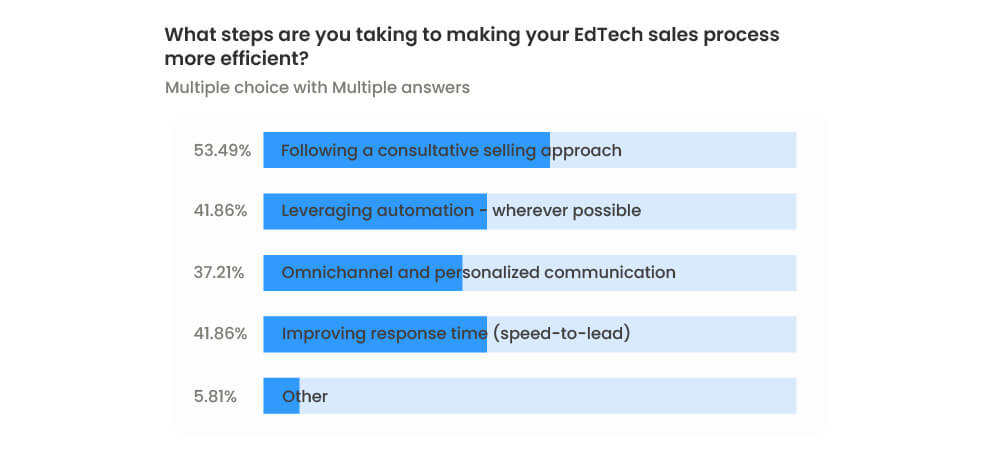
7 Highly-Effective Strategies for Scaling EdTech Sales
1. Strengthen Lead Acquisition & Management
The digital shift has opened up a much larger market. According to a study by INC42, the Indian EdTech market is likely to grow 3.7x in the next five years – from $2.8 Bn in 2020 to $10.4 Bn in 2025. Hence, with this momentum, generating leads will not be an issue. But, converting them will be.
Recently, lead generation channels have also evolved. We now have social media, online and offline channels, aggregators, and channel partners to find leads.
With so many distinct sources, tracking leads and mapping their journey becomes very difficult. Often, 80% of the leads are lost owing to a lack of follow-ups. Therefore, while scaling sales, it is necessary to equip your sales teams with lead management tools. After all, what’s the purpose in investing heavily in lead-gen and a large sales team, when you end up losing them.
After the lead acquisition, ensure that your sales reps attend them on time. Reaching out to a lead immediately after they submit a query increases the likelihood of conversion. Thus, EdTechs can achieve efficient lead acquisition, distribution, and management with a CRM solution designed for educational needs.
2. Make Data-driven Decisions
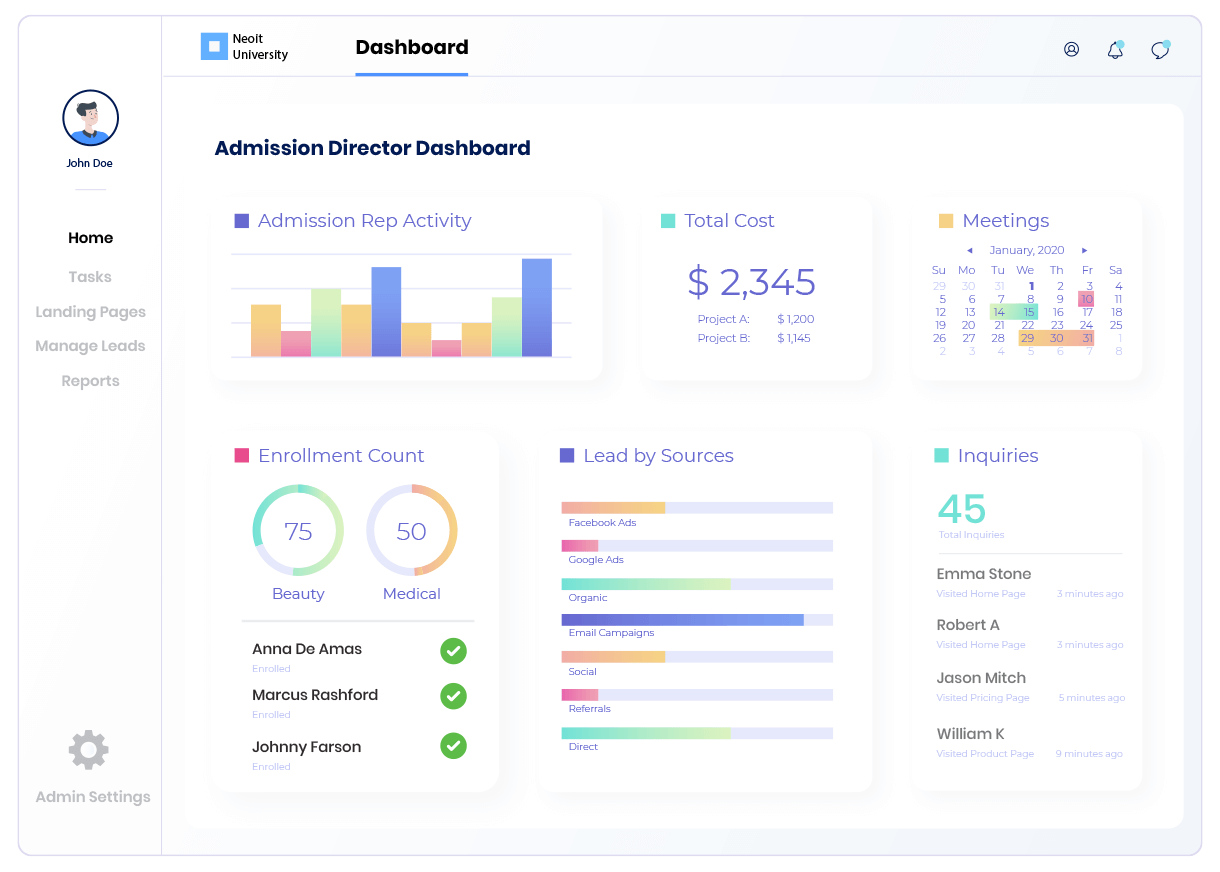
Tracking the right set of data can help you make informed decisions. Analytical dashboards simplify tracking of KPIs and relevant metrics. Hence, with analytical tools, the management can track the performances of marketing, sales (online and offline teams), admissions, customer outreach teams, call center teams, and more.
With this, you can differentiate profitable lead sources, understand lead stages, and get insights into an individual and the team’s overall performance. Admins can also track their product (subjects, courses) performance, campaign source performance, and return on ad spend (ROAS).
Following are the commonly tracked Edtech metrics:
| Daily operating metrics | Metrics for long term |
|---|---|
| Daily Calls Made | Revenue per employee |
| Email open and clickthrough rates and the best time for sending Emails | Hourly, weekly, monthly trends |
| % of target achieved per salesperson, team, and region | Profitable sources of leads |
| Call to conversion ratios | PAN India and location wise team performance |
3. Adopt New Pricing Models and Train Sales Reps Accordingly
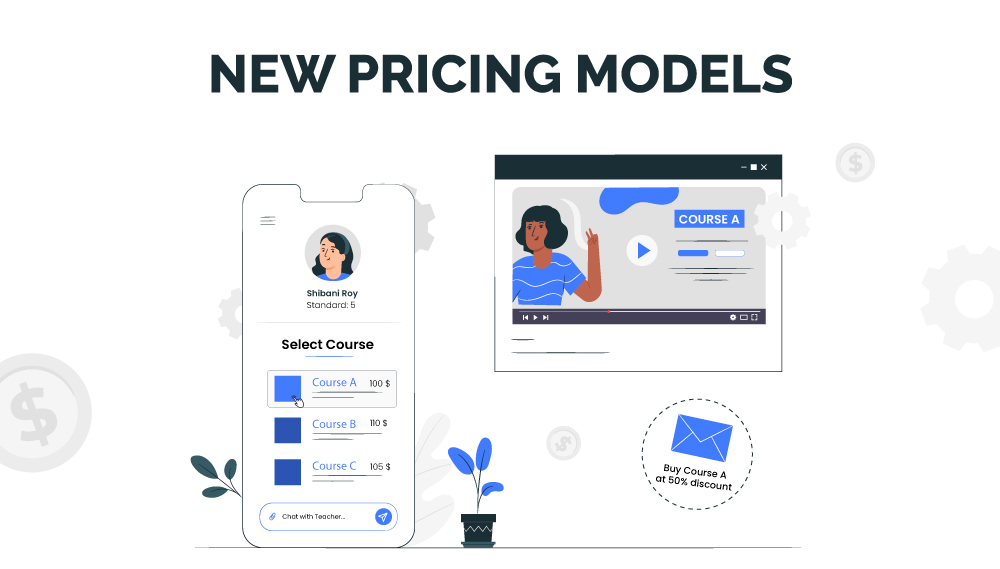
EdTechs have revised their pricing to acquire more students. Additionally, they are acquiring customers at a lower cost and relying on upselling and cross-selling for customer retention. This strategy has proved beneficial for EdTechs to achieve their revenue targets.
Many Edtechs are reconsidering their pricing modules and offering various benefits such as discounts and a “packet-sized” pay model where the student pays for a particular chapter in the syllabus. They are also collaborating with financial institutions to enable the approval of loans easily.
Organizations are providing students with an opportunity to make part payments. For example, if half an academic year is already complete, instead of paying for the whole course, students can pay only for the portion of the syllabus that is left. This strategy of making the courses flexible can attract a lot more students than before. This, in turn, would justify the idea of scaling the sales team.
4. A Shift to the Inside-Sales Model

There was a sudden shift from the home-demo model to an inside sales model. While edtech organizations struggled initially to replicate the personalization seen in face-to-face sales as they sold online, the overall digital adoption (both for salespeople and the customers) has been positive.
Additionally, today, organizations are spending nearly 70% of their sales and marketing budget on automating their processes.
Last year, digital solutions helped organizations enable communication, connect communities, and adopt work from home culture. Nearly 98% of the workforce worked from home for nine months and are now gradually returning to offices. Remote workforce tools ensured productivity and business continuity during the pandemic, and this trend will continue to empower businesses.
With the help of a remote workforce management solution, you can:
- Keep track of employees working from home
- Get insights into the productivity of your teams
- Keep your data safe while working from home
- Track phone calls/meetings/messages
- Ensure work carries on in case of bad/no network connectivity
- Set up internal notifications and escalations
5. Invest in Training Sales Teams
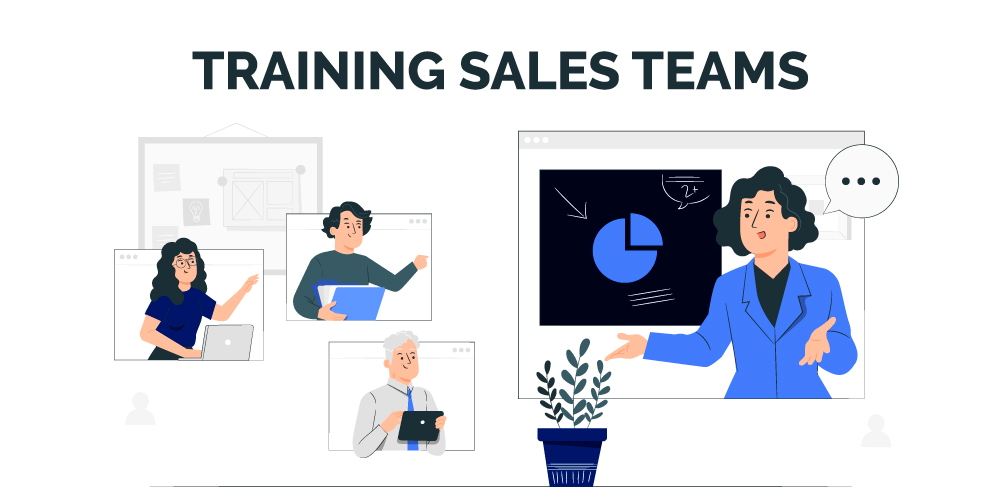
Every prospect has different demands and is unique in their own way. You cannot influence all of them with the same pitch. It is, therefore, crucial to train your sales team on the latest tactics to improve communication at each step of the sales process and give personalized experiences at scale. Also, challenge them to keep learning on their own.
With changing times and processes, technology had to come in someday. Sales teams are using personalization and flexibility as a major advantage in digital learning. Hence, it is here to stay and will leave a long-lasting effect.
Pravin Prakash, CPO, BYJU’S
6. Devise Incentive Strategies
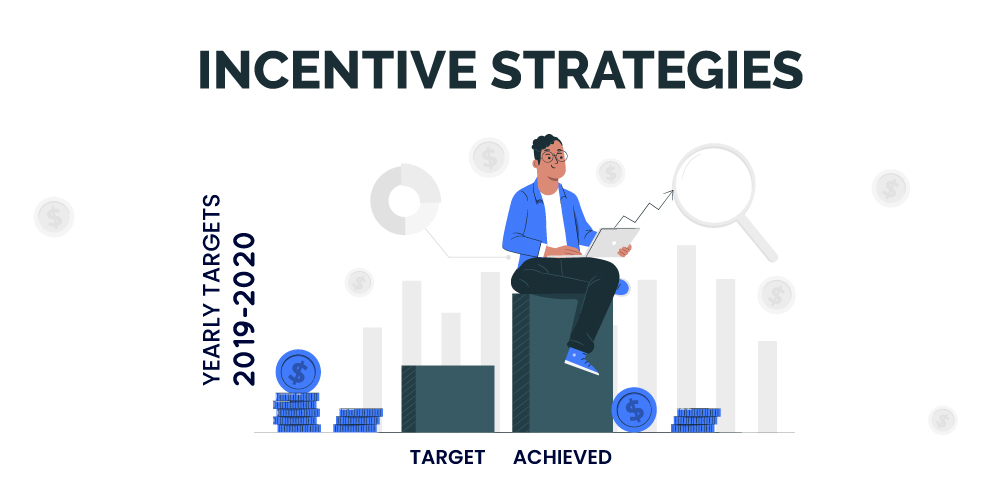
Think about ways to develop and retain top performers – have a better long-term incentive structure, and trust them with more leadership opportunities. With the competition around EdTech, having aggressive sales leaders and strategies can help capture market share.
For instance, one should have a strategy to generate ten leads and convert at least three of them. This can, of course, differ based on regions and conversion models. But always remember to define this benchmark.
This is where an EdTech CRM can help you evaluate the performance of sales reps, draw KPIs, define benchmarks, and build better incentive structures.
The whole idea is to be perseverant. There are fluctuations in the sales cycle across seasons. That does not mean your service doesn’t fit the market requirements. Essentially, now that the effects of the pandemic are slightly fading off, it is time to re-evaluate strategies. One should be open to adaptability and re-evaluate their sales and marketing strategy every three months or so.
Dheemanth Reddy SV, Head of Operations & Sales, Unschool
7. Use Smart Automation
One-to-one marketing is essential when it comes to high-velocity sales. Additionally, personalizing the offering according to a prospect’s intent helps increase conversion rates.
In LeadSquared, when we started personalizing product demos according to the user, we saw conversion rates go up by 40%. It is very important to curate and deliver content according to what the customer wants rather than having a generic pitch.
Murali Krishna, Director – Sales Operations, LeadSquared
Generating high-quality student inquiries is difficult in the first place. So, you must have a proper lead nurturing strategy to prevent lead wastage. And you can do it efficiently only when you know the intent of the prospects.
Now, this is where automation comes into the frame. By understanding the prospects’ intent, admission agents can strike relevant conversations and convert them. But there is more to automation which helps in scaling sales. You can use automation to improve the following:
- Distribute student inquiries to sales reps
- Handle back-office tasks
- Reduce response time
- Set-up highly personalized campaigns at scale.
All these can reduce the workload of sales reps and at the same time improve customer experience.
We asked education industry leaders about the process they have automated already. 46.94% of respondents have automated capturing course inquiries, 32.65% have automated call-center operations, 30.61% automated student activity tracking, 14.29% have automated teacher onboarding.
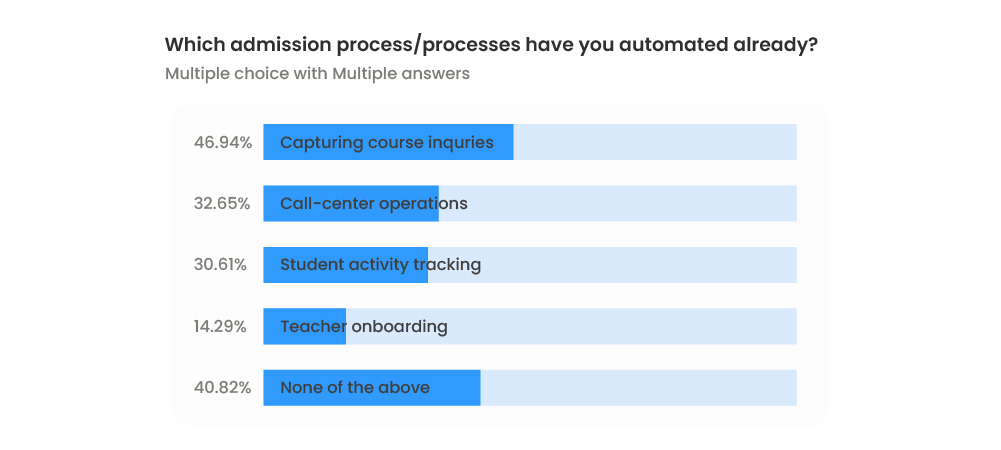
In Conclusion
Moving forward, we will witness a lot of innovation in sales process automation. In short, redefining the customer experience will be the prime focus of EdTechs.
We asked industry leaders about the tools that can help scale EdTech sales operations. 75.76% of respondents chose CRMs for EdTech, 54.55% opted for chatbots, 65.15% said dialers (click-to-call facilities on CRMs), and 43.94% chose data aggregators.
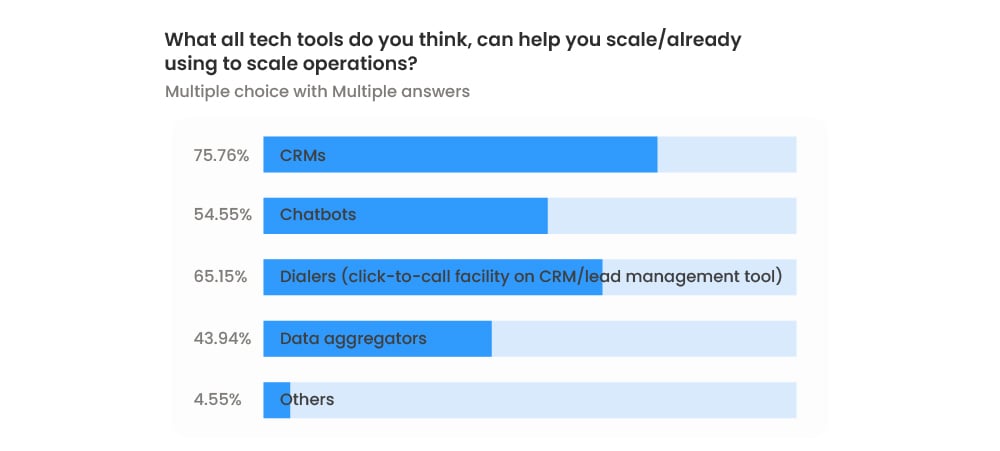
Automation is crucial when it comes to scaling sales. Therefore, organizations are implementing automation at each step – from lead generation to conversion. The following are the most common use cases of automation:
- Capturing Leads
- Distributing them to the relevant sales/admission counselors
- Prioritizing the student inquiries based on sales readiness
- Automating tasks/notifications and reminders
- Automating personalized engagement
If you want to know how we help BYJU’S, Vedantu, Unacademy, Upgrad, CrackVerbal, and other top EdTechs with their sales process and strategies, do reach out to us!
FAQs
To measure sales scaling with data track key metrics like Customer Acquisition Cost (CAC), Customer Lifetime Value (CLTV), sales conversion rates, and free trial/demo conversion rates. Establish benchmarks and use data to identify areas for improvement.
Content marketing can establish thought leadership, nurture leads, and drive traffic through SEO. Create valuable content like blog posts, webinars, or ebooks to attract potential customers.
EdTech companies can manage CAC through target marketing efforts, explore high-ROI channels, leverage free trials/demos, and optimize their sales funnel to improve conversion rates and lower CAC.







